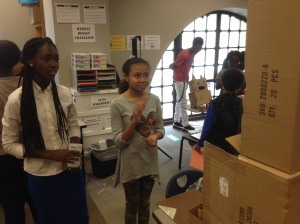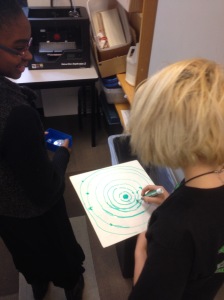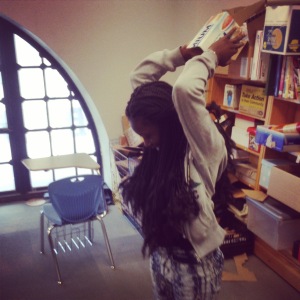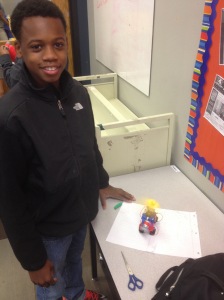This past year was swamped with curriculum design for four new Makerspace courses. Though there are many aspects in each of the courses that need to be tweaked, some of our projects were immediately and massively successful. For a GCAA Makerspace project to be successful, it should engage students while furthering their understanding of design thinking.
In the spirit of my guiding star for 2015-2016 being #documentation, here are my top ten curricular wins from 2014-2015.
1) Caine’s Arcade Unit
Guiding Question: How might we engage 6th graders in a carnival atmosphere?
Resources: To build empathy we watched Caine’s Arcade, this CBS News clip, and interviewed each other about previous carnival experiences. 7th & 8th grade Makerspace students validated their projects via visiting 6th graders who spent “tokens” for their games and provided feedback on a post-carnival survey.
2) Pixel Press Unit
Guiding Question: How might we make the most fun game level?
Resources: Lesson plans for a 1-day and 5-day experience can be downloaded here. Projects were validated by publishing the levels on the Pixel Press Arcade and monitoring the play count.
3) Invent It Challenge
Guiding Question: How might we design a product to solve a personal, school, community, or global challenge?
Resources: Guidelines, PowerPoint slideshows, and submission templates can downloaded here (scroll to the bottom). Students designed inventions and accompanying presentations to submit to the ePals judges.
4) Shark Tank Challenge
Guiding Question: How might we convincingly pitch a new product?
Resources: Students proposed designs using this form, then developed their products, and pitched them in a Shark Tank style to the class. Sharks evaluated pitches using this rubric from Startup Weekend.
5) A Crash Course in Design Thinking
Guiding Question: How might we improve the gift giving process?
Resources: This is a tried & true challenge designed by folks at the Stanford d.school. I use it during the first week as an introduction to the space. It is documented well here.
6) Chip Challenge
Guiding Question: How might we efficiently ship a single Pringle chip in the mail?
Resources: These constraints guided our project. We started building empathy by watching these Journey of a FedEx Package and So You Want to be a Mail Carrier videos. We then prototyped, tested, and exchanged chips with students at Nipher Middle School in Kirkwood.
7) Scratch Programming
Guiding Question: How might we use computers to creative?
Resources: This curriculum guided our work. We started with the Getting Started tutorial, then did the About Me Project and Maze Game before students proposed & created their own project ideas. Before starting Scratch, Twine served as an effective tool for designing choose-your-own-adventure style games.
8) Thingamabob Challenge
Guiding Question: How might we use material constraints to enhance creativity?
Resources: This is an exercise in ideation based of of the Thingamabob show. Students were given a random item and worked with a partner to generate a list of ten radically different useful devices that could be made with the item. Students then refined, prototyped, and tested their ideas.
9) Art Bots
Guiding Question: How might we autonomously create art?
Resources: The Tinkering Studio has wonderful documentation for their Scribbling Machines project.
10) Business Design Challenge
Guiding Question: How might we market a product to GCAA students?
Resources: Similar to the Shark Tank Project, students proposed designs using this form. For this project, the constraint was that the user had to be GCAA students. Students completed an empathy map for a “GCAA student,” proposed products, developed business plans, applied for loans, built their products, and then sold them in our Makerspace store.





Pingback: Three Models for Makerspace Learning | The GCAA Makerspace